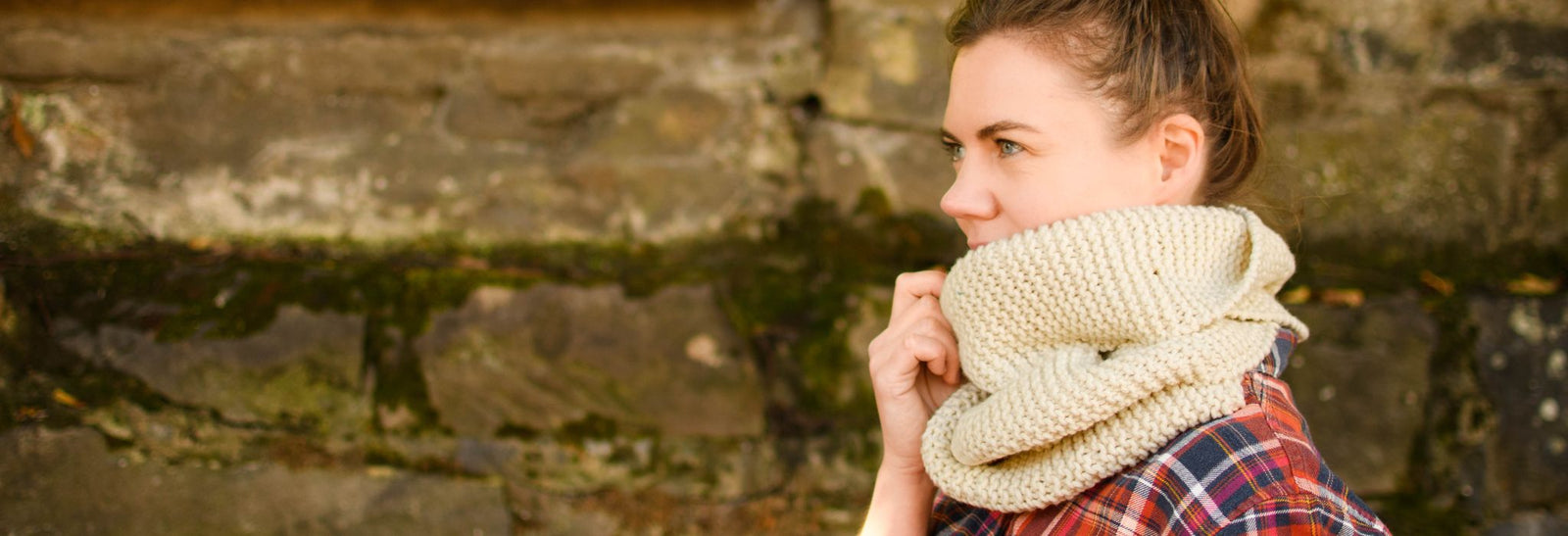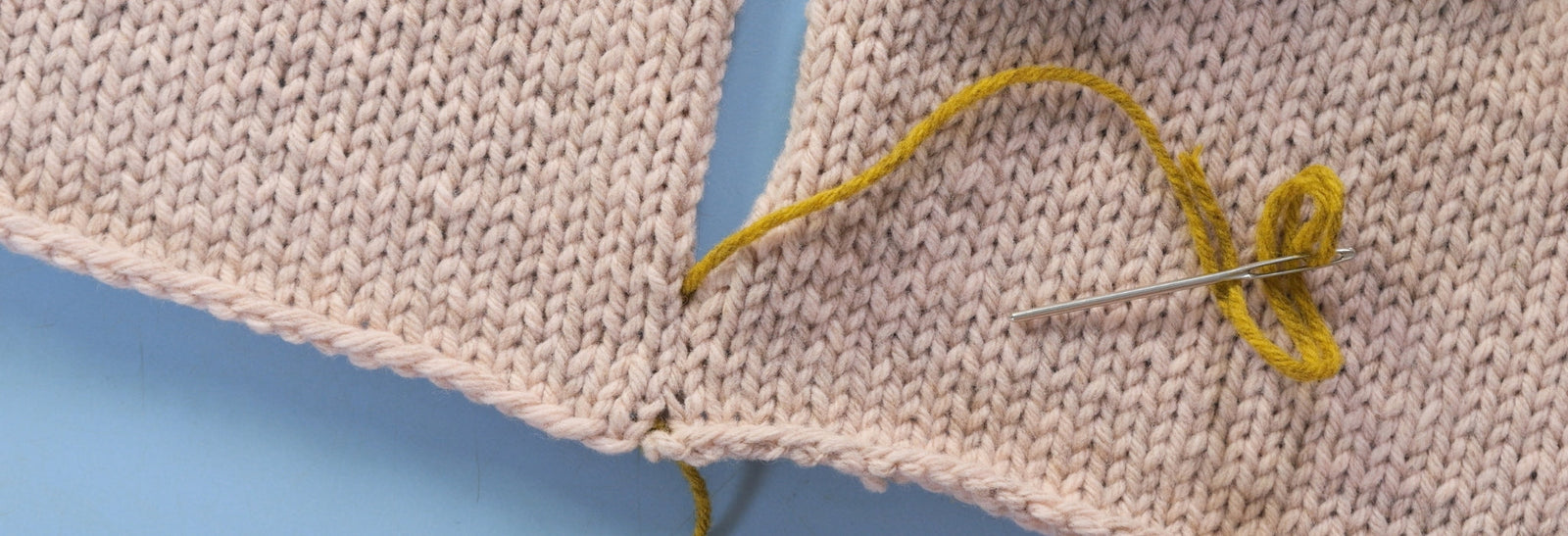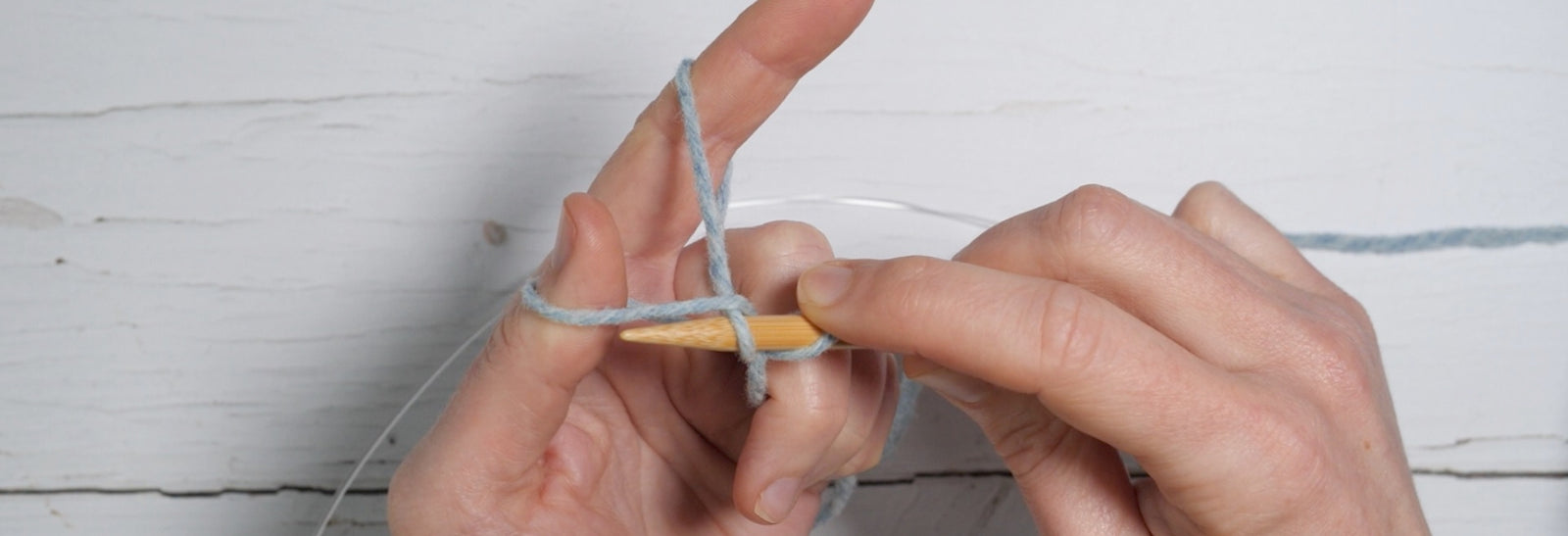Your Cart is Empty

How to Knit a Scarf: A Beginners Guide to Scarf Knitting
March 23, 2023

Learning how to knit a scarf is an easy project for beginners because it only requires 3 basic skills;
- Casting on
- The knit stitch
- Binding off (known as casting off in the UK)
It's the perfect foundation for becoming a knitter, since you'll use these skills in every project going forward.
You'll also learn to select materials for a project, slip a stitch, join a new ball of yarn and weave in the loose ends of the yarn.
To Knit a Scarf You Will Need
Yarn
For this free knitted scarf pattern you will need:
305 yards / 280m of Bulky (aka Chunky), 230 yards / 210m of Super Bulky (aka Super Chunky) OR 155 yards / 140m of Jumbo Weight yarn.
What Kind of Yarn is Best for Beginners?
Thicker yarns can be easier for beginners to use to than very fine yarns: it's easier to manipulate the yarn and needles, and to see what you're doing. Using a thick yarn also means that your scarf won't take as long to complete, and you're less likely to get bored.
Even amongst thicker yarns, there can be a lot of variation! We've included 3 sets of numbers in the pattern, so that your scarf will turn out roughly the same size no matter how thick your "thick" yarn actually is. Very thick yarns, and correspondingly large needles, can be harder to learn with than ones at the thinner end of this range, but the tradeoff is that your scarf will knit up faster. It's your choice!
On the yarn label you should see the yarn weight, and a suggested needle size. There might also be a number for the yarn. Look for a yarn that is labelled bulky (aka chunky), super bulky (aka super chunky) or jumbo weight or numbered from 5 to 7.

Symbols via the Yarn Craft Coucil
Yarn can also be made from many different types of fibre, and have a range of textures.
As a beginner knitter you'll find it easier to work with yarns that are relatively smooth, and have some "memory". This means that you can stretch the yarn a little bit and it will bounce back when you let go.
100% wool or a blend of wool and synthetic or plant fibres are ideal. 100% silk or plant fibre yarns are harder to work with as a beginner and won't make a warm, cosy scarf.
How much yarn do I need for a scarf?
To knit a scarf, 200g of yarn should make an average width and length scarf. If you want a wider scarf, or you're Dr Who, you'll need extra yarn.
To Knit a Scarf We Used
2 balls of StyleCraft ReCreate Chunky (40% wool, 30% acrylic, 30% polyester, (all recycled) 153 yards / 140m, 100g) in the shade Ecru for this project.
Needles
You should use a pair of straight needles OR 24"/60cm or 32"/80cm circular needles, in the size recommended for your yarn for this scarf pattern.
If a range of needle sizes is recommended choose a needle at the larger end of this range.
If there is no recommended needle size for your yarn, we suggest using
- US 11/7-8mm needles for chunky weight yarn
- US 15-17/10-12mm needles for super chunky yarn
- US 19/15mm needles for jumbo weight yarn
to complete this scarf pattern.
What Knitting Needles Should I Use as a Beginner?
Knitting needles come in 3 main types: straight, circular and double pointed.
As a beginner you can use either a pair of straight needles, or a circular needle to knit a scarf.
Shorter straight needles are easier to control than very long ones. Circular needles are more portable, and will be more versatile as you grow your skills beyond knitting a scarf because they can also be used for knitting in the round. They come in different lengths: make sure to get a 24" (60cm) or 32" (80cm) needle for this project.
Bamboo or wooden needles are much easier for beginners to use than metal needles. They're less slippery so they'll grip your stitches and you'll be less likely to accidentally drop a stitch off the end.
Other Notions
Tapestry needle / yarn needle - with a blunt tip and an eye big enough to easily thread your yarn through.
You'll use this to weave in the loose ends of yarn when your scarf is complete.
Measuring tape (optional)
Scissors
Reading the Pattern
The pattern includes 3 sets of numbers to cast on.
Use the first number if your yarn is chunky, the second if it's super chunky, and the third if it's jumbo weight.
Directions to Knit a Scarf
To begin knitting a scarf you will cast on 24 [18, 12] stitches.
Visit our long tail cast-on blog post for a step-by-step guide, if you don't know how to do it.
Row 1: slip the first stitch, then knit every stitch to the end of the row.
Repeat row 1 until your scarf measures 63"/162cm, or your desired length.
The exact length will vary depending on your yarn, but your scarf is likely to grow about 10% once it has been washed for the first time. You can keep knitting until the yarn that remains is about 4 times longer than the width of your scarf (you need this to bind off).
Bind off all of the stitches.
(There is an example of how to do this in the PDF pattern)
Weave in your ends to finish off. Weaving in ends blog post will show you how this is done.
Gently hand wash your finished scarf and lay it flat to dry.
If you plan on gifting your brand new knitted scarf, there is a gift tag included in our free PDF pattern.
And that's it, you have knit a scarf!

Also in Journal

Learn to Knit: Mattress Stitch
March 29, 2023
By following our step-by-step mattress stitch knitting tutorial, you'll learn how to make your seams look beautiful and how best to prepare your knitting so that when you seam it with mattress stitch, it goes smoothly on the first try.
Read More
Learn to knit: the long tail cast-on
February 03, 2022
The long tail cast on is a great multi-purpose knitting cast on and the perfect place for beginner knitters to start. Learn how to work the long tail cast on and how to estimate the length of yarn needed with our clear step by step tutorial and video.
Read More
How to Kitchener Stitch
December 09, 2021
Kitchener stitch is a knitting technique used for grafting together two sets of live stitches, most often stockinette stitch. Instead of binding off and sewing two edges together, you can use a tapestry needle and yarn to join the stitches completely seamlessly.
Read More Recent Articles
- Learn to Knit: Mattress Stitch March 29, 2023
- How to Knit a Scarf: A Beginners Guide to Scarf Knitting March 23, 2023
- Learn to knit: the long tail cast-on February 03, 2022
- How to Kitchener Stitch December 09, 2021
- Crochet Provisional Cast-on December 02, 2021
- Learn to knit: How to knit in the round with double pointed needles November 25, 2021
- Learn to knit: How to knit in the round using the magic loop technique November 25, 2021
- Learn to knit: How to knit in the round November 25, 2021
- Knitted Gift Ideas for you and your loved ones November 18, 2021
- Celebrating our Porty Hat Preview Knitters October 28, 2021
Free resources
-
KALS, step-by-step pattern guides and free patterns
Learn brioche with the free Daniel's Hat pattern
Tombreck - a free chevron beanie pattern
Working the brioche neck detail on the Polwarth sweater
Basics
Casting on
Decorative Channel Island Cast-on
Binding off
3 Easy Stretchy Bind-offs (p2tog bind-off; k2togtbl, k1 bind-off; Jeny's surprisingly stretchy bind-off)
Tubular Bind-off for brioche stitch
Increasing
Paired increase methods compared
Decreasing
Brioche stitch double decreases
Knitting in the round
How to Knit in the round using Magic Loop
How to Knit in the round using DPNs
Short rows
Swatching and gauge
Tips and tricks
Avoiding ears when binding off
Tighter purl stitches for neater cables and ribbing
Cabling without a cable needle
Reading knitting patterns
Understanding "continue in pattern"
Finishing
Garment knitting
Joining the body and sleeves on a seamless bottom up sweater
Sizing
Inclusive garment knitting
How to pick a garment without a model for you (specifically addresses finding garment patterns when your gender identity isn't represented and the styles you want to knit might not be sized to fit your body)
How does ease affect inclusive size ranges?
Specific stitch patterns
Lace
Identifying and fixing mistakes in lace knitting
Colourwork
Getting started with stranded colourwork
Understanding colour dominance
Working stranded colourwork over small circumferences
Decreases in stranded colourwork
Holding the yarn for stranded colourwork
Ladderback Jacquard (a neat way to deal with long floats)
Cables
Cabling without a cable needle
Cabling without a cable needle on the wrong side
How to knit cabled decreases
Closed ring cable increases and decreasesBrioche
How to work brioche stitch in the round
Other crafts
Cross stitch
How to begin your first large cross stitch project
How to finish a cross stitch project with an embroidery hoop frame
Mending

Sign up today
Find out the latest news from the studio such as sales, pattern releases, and new workshops or KALs our learning community, The Knitwork. We also share helpful tips and exclusive subscriber discounts...

